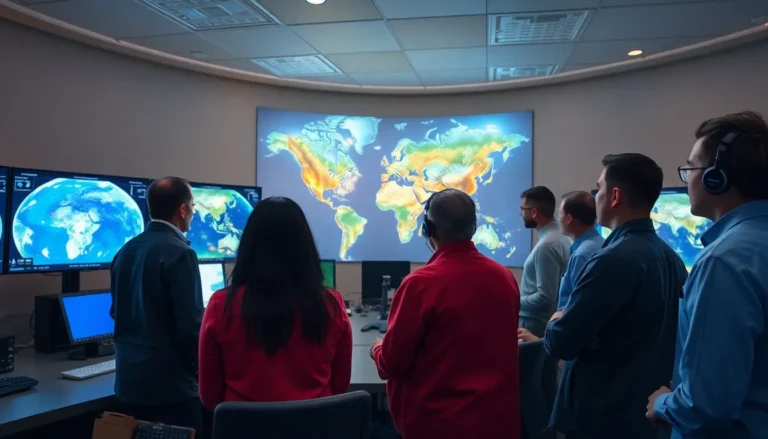Table of Contents
ToggleIn a world bursting with colors, cultures, and perspectives, diversity news shines like a disco ball at a dull party. It’s not just about checking boxes; it’s about celebrating the rich tapestry of human experience. From groundbreaking initiatives to heartwarming success stories, diversity news keeps everyone in the loop about the vibrant changes shaping our society.
Importance Of Diversity News
Diversity news plays a pivotal role in highlighting various human experiences and perspectives. It showcases the significance of different cultures, traditions, and identities that shape society. Promoting an understanding of these dimensions fosters empathy among individuals, contributing to a more inclusive community.
Organizations benefit from diversity news by showcasing initiatives that support underrepresented groups. Articles about successful programs can inspire others to implement similar practices. Such narratives often capture unique stories that resonate with diverse audiences, driving engagement and action.
Awareness of diversity issues can lead to positive societal changes. Readers exposed to these topics often become advocates for equality and justice. Incidentally, exposure to variety in narratives encourages dialogue, opening doors for discussions on sensitive issues.
Moreover, diversity news empowers marginalized voices, giving them a platform to share their stories. It is essential to amplify these perspectives as they enrich public discourse. Publications focusing on diversity not only inform but also challenge stereotypes.
Finally, diversity news sets a benchmark for accountability in reporting. By prioritizing inclusive storytelling, media outlets can shift the narrative towards equity. This commitment enhances credibility and strengthens community ties, ultimately paving the way for a more integrated society.
Current Trends In Diversity News

Diversity news continues to highlight crucial issues surrounding representation and social progress. Organizations and platforms prioritize diverse voices to foster inclusive narratives that encourage dialogue.
Representation In Media
In recent years, media representation has transformed with increased visibility for marginalized groups. Companies amplify stories from diverse backgrounds, allowing representation across different genres. Progress includes more inclusive casting in films and series, challenging traditional stereotypes. Experts assert that representation influences public perception and drives social change. Audiences respond positively to authentic narratives that reflect their experiences. As a result, media executives recognize the demand for inclusivity, leading to diverse storytelling practices.
Coverage Of Social Issues
Coverage of social issues has shifted focus towards underrepresented perspectives, addressing systemic inequalities. Reporters unveil stories that highlight the struggles faced by marginalized communities. Campaigns on platforms raise awareness regarding issues like racial justice, gender equality, and LGBTQ+ rights. The media plays a key role in shining a light on grassroots movements, inspiring activism and engagement. Advocates argue that this coverage helps to legitimize concerns and mobilize support for change. Consequently, the public becomes more informed and empathetic toward diverse experiences and challenges.
Sources Of Diversity News
Diversity news draws from various sources, providing a multifaceted view of different cultures and perspectives. These sources play a pivotal role in shaping how society perceives diversity.
Traditional Media Outlets
Television networks and newspapers remain essential for delivering diversity news. They report on significant events, such as cultural celebrations and social movements, ensuring broad reach and awareness. As standards evolve, many outlets prioritize diverse voices in their storytelling. Broadcasters increasingly include segments that focus on underrepresented communities, fostering a deeper understanding of issues. Print media amplifies this by featuring articles that highlight success stories, advocacy efforts, and challenges faced by marginalized groups. This visibility in traditional media boosts community engagement and encourages informed discussions.
Online Platforms
Digital spaces now serve as powerful hubs for diversity news. Websites, social media channels, and blogs provide immediate access to diverse narratives across various platforms. They encourage user engagement and allow marginalized voices to share experiences and insights. Content on social media often sparks viral conversations and activism, connecting individuals globally. Influencers and activists leverage these platforms to raise awareness about social justice issues and promote inclusive initiatives. Various organizations harness online tools to spread messages rapidly, thereby shaping public discourse and encouraging empathy and support for diversity-related causes.
Challenges In Reporting Diversity News
Challenges in reporting diversity news often stem from systemic issues within media organizations.
Bias And Misrepresentation
Bias and misrepresentation undermine the credibility of diversity news. Media outlets sometimes present narratives that do not accurately reflect the complex experiences of diverse communities. Inaccurate portrayals reinforce stereotypes, leading to misunderstandings about these groups. For instance, frequent negative coverage of certain communities can shape public perception unfairly. Reporters must prioritize nuanced storytelling, ensuring that varied perspectives are included. Engaging with community members during the reporting process fosters authenticity. Employing diverse journalists can also help mitigate bias, as their lived experiences often contribute valuable insights.
Accessibility Of Information
Accessibility of information remains a significant barrier in diversity news coverage. Many underrepresented communities lack equal access to mainstream media platforms that disseminate information. For example, digital literacy and access to technology impact the ability of some individuals to engage with online news sources. Creating multimedia content ensures different audiences can access information in their preferred format. Additionally, organizations should focus on outreach efforts, targeting platforms that reach diverse populations effectively. Collaborations with community organizations can bridge the gap and promote awareness of critical issues affecting these groups. Prioritizing inclusivity in content distribution enables broader engagement and understanding.
Diversity news plays a pivotal role in shaping a more inclusive society. By amplifying underrepresented voices and highlighting cultural richness, it fosters empathy and understanding among communities. The ongoing transformation in media representation not only challenges stereotypes but also drives social progress.
As organizations and platforms prioritize diverse narratives, they inspire advocacy and engagement on critical issues. This shift encourages public discourse that legitimizes the experiences of marginalized groups. While challenges exist in accurate representation, the commitment to inclusive storytelling is essential for creating a more equitable world. Embracing diversity in news coverage ultimately enriches societal dialogue and paves the way for meaningful change.




